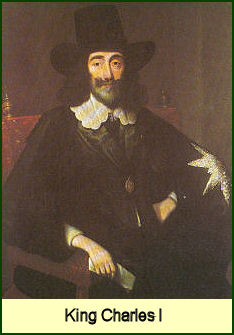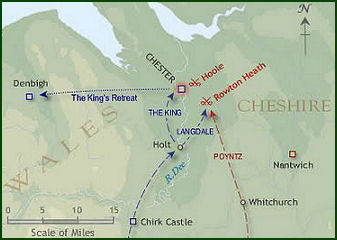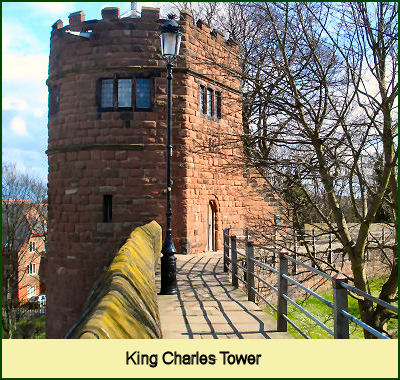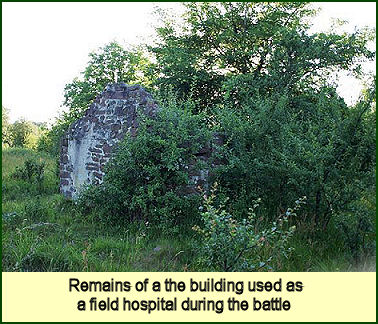The Battle of Rowton Heath
 The Civil War battle of Rowton Heath took place 2 miles to the south-east of Chester on 24th September 1645. Chester had been a stalwart Royalist stronghold from the beginning of the war. Its circuit of defensive walls was repaired and strengthened during 1642-3 and an outer ring of earthwork defences was constructed.
The Civil War battle of Rowton Heath took place 2 miles to the south-east of Chester on 24th September 1645. Chester had been a stalwart Royalist stronghold from the beginning of the war. Its circuit of defensive walls was repaired and strengthened during 1642-3 and an outer ring of earthwork defences was constructed.
Following his defeat at the Battle of Nantwich in January 1644, the Royalist commander Lord Byron withdrew to Chester from where he continued operations against Sir William Brereton, the Parliamentarian (Roundhead) commander in Cheshire. Parliamentary forces gradually gained control of much of Cheshire during the early half of 1645, but the Royalists still held the crossing of the River Dee at Chester which gave access into north Wales. After his defeat at Naseby, Charles' hopes were focused on reinforcements from Ireland or of a junction with Montrose in Scotland. Chester was to become the key to both strategies.
 Chester, now the last port still in Royalist hands, was besieged by the Parliamentarians in December 1644. On 20th September 1645, a force under the command of Michael Jones attacked the Royalist barricades, which took the city's Royalist defenders totally by surprise and they were forced to fall back back to the inner city. Parliamentarian artillery began bombarding the city on 22nd September and after making a breach in the city walls they attacked in two places. Both attacks were repulsed by the Royalists. A cannon battery placed in St John's churchyard breached the city walls near the Roman amphitheatre. A hole some 25 feet wide was made in the wall. Repairs made to this breach in the wall are still visible to the present day, in the section next to the Roman Gardens.
Chester, now the last port still in Royalist hands, was besieged by the Parliamentarians in December 1644. On 20th September 1645, a force under the command of Michael Jones attacked the Royalist barricades, which took the city's Royalist defenders totally by surprise and they were forced to fall back back to the inner city. Parliamentarian artillery began bombarding the city on 22nd September and after making a breach in the city walls they attacked in two places. Both attacks were repulsed by the Royalists. A cannon battery placed in St John's churchyard breached the city walls near the Roman amphitheatre. A hole some 25 feet wide was made in the wall. Repairs made to this breach in the wall are still visible to the present day, in the section next to the Roman Gardens.
King Charles I arrived at the city on 23rd September, staying the night at Sir Francis Gamull's house on Bridge Street. The king ordered 3,000 horse under the command of Marmaduke Langdale to camp outside the city while he and 600 others entered Chester. His intent was to attack the besieging Parliamentarians from both sides.
Charles' force was made up of 3,500 horse, which was split into four brigades, the largest of these were the 1,200 soldiers of the Northern Horse headed by Sir Marmaduke Langdale. Gerard's brigade, consisted of around 800 men, William Vaughan's 1,000-strong brigade, and the 200 members of the Life Guards, Charles's personal bodyguard, under the command of the king's cousin, Lord Bernard Stewart, Earl of Lichfield (1622–1645).
 As the king entered Chester, the Parliamentary commander Sydnam Poyntz arrived in Whitchurch, around 15 miles away. On hearing news about the situation in Chester, Poyntz sent a message to the besiegers that he would advance to relieve them the following morning, this messenge was intercepted by Sir Richard Lloyd, however, who immediately notified Charles and Langdale.
As the king entered Chester, the Parliamentary commander Sydnam Poyntz arrived in Whitchurch, around 15 miles away. On hearing news about the situation in Chester, Poyntz sent a message to the besiegers that he would advance to relieve them the following morning, this messenge was intercepted by Sir Richard Lloyd, however, who immediately notified Charles and Langdale.
At a subsequent Royalist Council of War, it was decided that Gerard's force and the Lifeguards, along with 500 foot, would advance to either join with Langdale or prevent Colonel Jones's forces linking up with Poyntz. The king was to remain in the city, from where he watched the ensuing battle from the Phoenix Tower on the walls which later came to be known as King Charles' Tower.
 Langdale advanced north with around 3,000 cavalry, and at Miller's Heath, near the village of Rowton, on the morning of 24th September, he became aware of Poyntz's force of 3,000 also moving north.
Langdale advanced north with around 3,000 cavalry, and at Miller's Heath, near the village of Rowton, on the morning of 24th September, he became aware of Poyntz's force of 3,000 also moving north.
The battle took place on part of an large heath with cultivated land centred around the village of Rowton Heath, about 2 miles to the south east of Chester. Action commenced in the early morning and lasted throughout the day . Hedge-lined lanes divided the heath, Langdale lined the hedgerows with dragoons and dismounted troopers with carbines but due to the inaccuracy of Parliamentarian reconnaissance, Poyntz was unaware of Langdale's presence until the dragoons opened fire on his vanguard at approximately 7 am After half an hour of firce fighting at close-quarters at the mouth of the Whitchurch-Chester Road the Royalists were forced back, but Poyntz was attacked by a fresh group of Royalist troops and forced into retreat. Langdale sent a message to Charles in Chester, requesting reinforcements, but no orders were issued for a further six hours after that. The reasons for Charles hesitation remain unclear.
The Royalists in Chester observed the arrival of the Parliamentarian reinforcements under Colonel Michael Jones and John Booth and sent warning to Langdale's force, who withdrew nearer to Chester, reforming at Rowton Heath. At the same time the Royalists in Chester began to move and Gerard advanced. He hoped to attack Jones's force from the back, but the Parliamentarians responded by dispatching 200 cavalry and 200 infantry to prevent this occuring. This force met Gerard in a confused engagement on Hoole Heath in which the king's cousin, Lord Bernard Stewart was killed and Gerard's force was prevented from avancing to the aid of Langdale's. Also slain at the same time was William Lawes (1602–1645) a noted English composer and musician.
 Jones and Booth then linked up with Poyntz, giving a combined Parliamentarian force of 3,000 horse and 500 musketeers against a Royalist army which consisted of approximately 2,500 horse. At around 4 pm Poyntz advanced on the Royalists, Langdale attempted to counter-charge but the Royalists were soon outflanked. The Royalist army broke, some escaping via Holt Bridge and others fleeing towards Chester. On Hoole Heath the retreating Royalists met with part of Gerard's force and made an initially successful counter-attack before being forced back to the walls of Chester.
Jones and Booth then linked up with Poyntz, giving a combined Parliamentarian force of 3,000 horse and 500 musketeers against a Royalist army which consisted of approximately 2,500 horse. At around 4 pm Poyntz advanced on the Royalists, Langdale attempted to counter-charge but the Royalists were soon outflanked. The Royalist army broke, some escaping via Holt Bridge and others fleeing towards Chester. On Hoole Heath the retreating Royalists met with part of Gerard's force and made an initially successful counter-attack before being forced back to the walls of Chester.
Within Chester, in a confused melee, Parliamentarian musketeers fired into the retreating Cavaliers leading to a complete rout. Charles, still positioned at the Phoenix Tower on the city walls, quickly withdrew to the tower of Chester Cathedral, but this position also proved to be unsafe, as the captain who was standing next to him was shot in the head by musket fire from the victorious Parliamentarians who took residence in the St John's Church tower. The Royalists suffered heavy losses any hopes of resurrecting a royalist army were now crushed. The end of the first Civil War could not be long postponed.
On 25th September Charles fled Chester, he managed to slip out of Chester the following day via the Old Dee Bridge, retreating to Denbigh then to Newark. Lord Byron refused to surrender the city. The Parliamentarians constructed siege works to encircle the city and maintained a constant bombardment. The city's defenders repulsed attempts to take Chester by storm but conditions within the city worsened as winter set in . With many of its citizens citizens dead or dying of starvation, Chester finally surrendered to the Parliamentarians in January 1646. Sir William Brereton's forces occupied Chester on 3rd February 1646.
The battle took place in three stages and was spread over a wide area. The railway bridge, on a former line of the A41, provides a publicly accessible viewpoint over the battlefield. The site of the initial action still survives as farmland, although it is now bisected by the railway line and some quarrying has occured. The quarry is situated on what is likely to be the site of the initial royalist deployments and therefore much of the battle archaeology has been lost. Whitchurch Road (A41), the ‘narrow lane’ in which the first engagement occurred, remains largely on its original course. There is a footpath along the roadside allowing the visitor to follow the course of the initial parliamentarian advance and engagement and access to the abandoned original road is possible. There are footpaths on either side of the road which allow access to the battle site.The site of the final stages of the battle, within the early suburbs of Chester, has been absorbed in modern development.
Further Civil War reading
The Civil War Massacre of Barthomley and skirmish at Haslington
